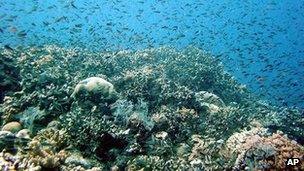Australia plans huge marine reserve in Coral Sea
- Published

The Coral Sea is home to diverse wildlife, including sharks and tuna
The Australian government says it plans to establish the world's largest marine reserve in the Coral Sea.
Environment Minister Tony Burke said the protected zone would cover an area more than one-and-a-half times the size of France.
New fishing limits would be imposed and and exploration for oil and gas banned.
The proposal is subject to a 90-day consultation, but Mr Burke said the Coral Sea's biodiversity was at the heart of the plan.
"There is no other part of Australia's territory where so much comes together - pristine oceans, magnificent coral, a military history which has helped define us and now a clear proposal for permanent protection," he said.
The sea - off the Queensland coast in north-east Australia - is home to sharks and tuna, isolated tropical reefs and deep sea canyons. It is also the resting place of three US navy ships sunk in the Battle of the Coral Sea in 1942.
'World leader'
Under the plans, fishing - commercial and recreational - would be allowed in some areas of the reserve, which at its closest point would start 60km (37 miles) from the coast and it extends out to 1,100km.
President of the Queensland Seafood Industry Association Geoff Tilton said a larger area was needed for commercial fishing.
But Professor Terry Hughes, director of coral reef studies at James Cook University, called the proposal a "welcome step" that "cements Australia's reputation as a world leader in marine resource management".
"The proposed Coral Sea no-take area is hundreds of kilometres offshore, and will have no impact on recreational fishing. There is very, very little commercial fishing currently operating legally in the Coral Sea today," he said.
Activists called the plan a good start but said key reefs and spawning grounds lay outside the fully protected area.
Currently the world's largest marine reserve is a 545,000-sq-km area (210,425 sq miles) established by the UK around the Chagos Islands in the Indian Ocean.
The Coral Sea reserve, if approved, would be approximately 989,842 sq km.
- Published3 October 2011